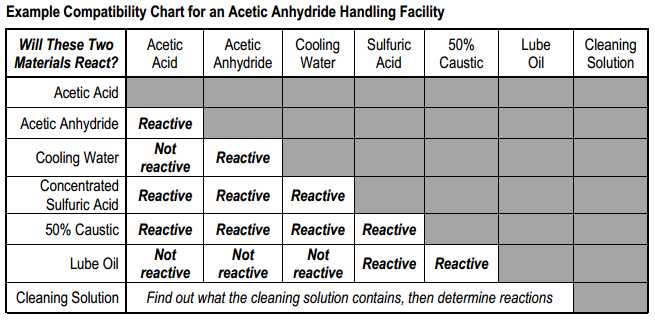Many materials that are not considered “reactive materials” can nevertheless react dangerously with other, incompatible materials. The other material may be there intentionally (addition of the right material, but in the wrong amount) or by accident (such as contaminants like rust or lubricants). Conditions under which the materials are used (pressure, temperature, humidity, concentration, etc.) can also change the reactive behavior dramatically. For these reasons, identifying reactivity hazards involving the mixing of two or more materials is highly situation-dependent and not readily addressable using a “cookbook” list, or rule-based prescriptive approach. This section presents an extrinsic approach to identifying reactive interactions that goes beyond the intrinsic properties of the individual materials that may be associated with your business.
Determining the potential for dangerous interactions is not always easy. Take concentrated sulfuric acid as an example. By itself, it is very stable unless heated to high temperatures. It is nonflammable, and has a fairly low vapor pressure. However, mix it with water, or worse, a caustic solution, and it can rupture a tank in seconds. The key to evaluating the reactive hazard in this example is to first identify that both concentrated sulfuric acid and caustic are present. Then, safeguards can be put in place to ensure the two materials do not come into uncontrolled contact.
The first thing to do is determine what you have on site, and then determine which materials are reactive with which other materials. There are some easy-to-use tools that can help in this analysis, and one of the best is called a compatibility chart. Other references may call this a chemical compatibility chart, a chemical interactivity chart, or a chemical interaction matrix.
A hypothetical example of such a chart is shown below. All intended chemicals and common contaminants (such as utility streams that might leak in) are listed on both the horizontal and vertical axes. Each box in the chart represents the interaction of the two gridded components. Each half of the chart represents all possible binary (two-component) mixtures. Therefore, only one half of the matrix needs to be filled out to assess possible two-component combinations. This kind of simple analysis does not consider order of mixing (X mixing into Y is treated the same as Y mixing into X), which may be an important consideration such as when handling strong acids.

Note that some of the “reactions” indicated by the chart are combinations where the heat generated by diluting a material may cause pressurization of an enclosure. Note also that more information is
needed about the chemical composition of the cleaning solution before its compatibility with the other materials can be determined.
At this point, we are not trying to decide how likely it is for the two materials to come together. We are only identifying what combinations pose a reactivity hazard. The questions addressed in the next two sections of this document will lead you to consider what data are needed to determine the severity of an interaction and whether safeguards are adequate to keep incompatible materials from being combined in an uncontrolled manner.
Completing a compatibility chart often requires persistence and determination. You or someone in your organization may be able to readily answer whether most combinations are reactive or not. A few combinations may take more work. One way to do a quick check on chemical combinations is to use a method such as the Chemical Reactivity Worksheet, available free of charge (see the Where Can We Get More Help? section of this document under Reactive Interactions). This program has over 6,000 chemicals in its database, and predicts the results of two-chemical mixtures by reactive group combinations. The Worksheet not only indicates possible hazardous interactions, it also sets up a compatibility chart and indicates potential consequences of the interactions (e.g., “Heat generation by chemical reaction, may cause pressurization”).
Some other important considerations at this stage:
- MSDSs and the literature may not provide the information needed, especially if the chemicals being used are not common or are new materials under development. In these situations, specific testing may be needed to provide enough information to accurately fill out the compatibility chart.
- A compatibility chart only considers two-component mixtures. Consider also whether any interactions among three materials are hazardous; e.g., one acting as a catalyst for the reaction of two others.
- Check with your purchasing people to find out what materials are brought on site.
- Do not overlook materials that are produced on site, including chemical intermediates.
- Be careful about ruling out materials on the basis of quantity alone. Mixing liquid waste materials in 55-gallon drums has resulted in numerous incidents. Acetylene in contact with copper can produce shock-sensitive copper acetylides, which can be dangerous in very small quantities.
- Consider materials such as air, water, oil, or foreign objects that could be left inside equipment during cleaning or maintenance operations. Physical processing conditions, such as temperature, pressure, humidity, and oxygen content should also be considered.
- Be sure to consider the possibility of mixing materials in your waste disposal or sewer system.
